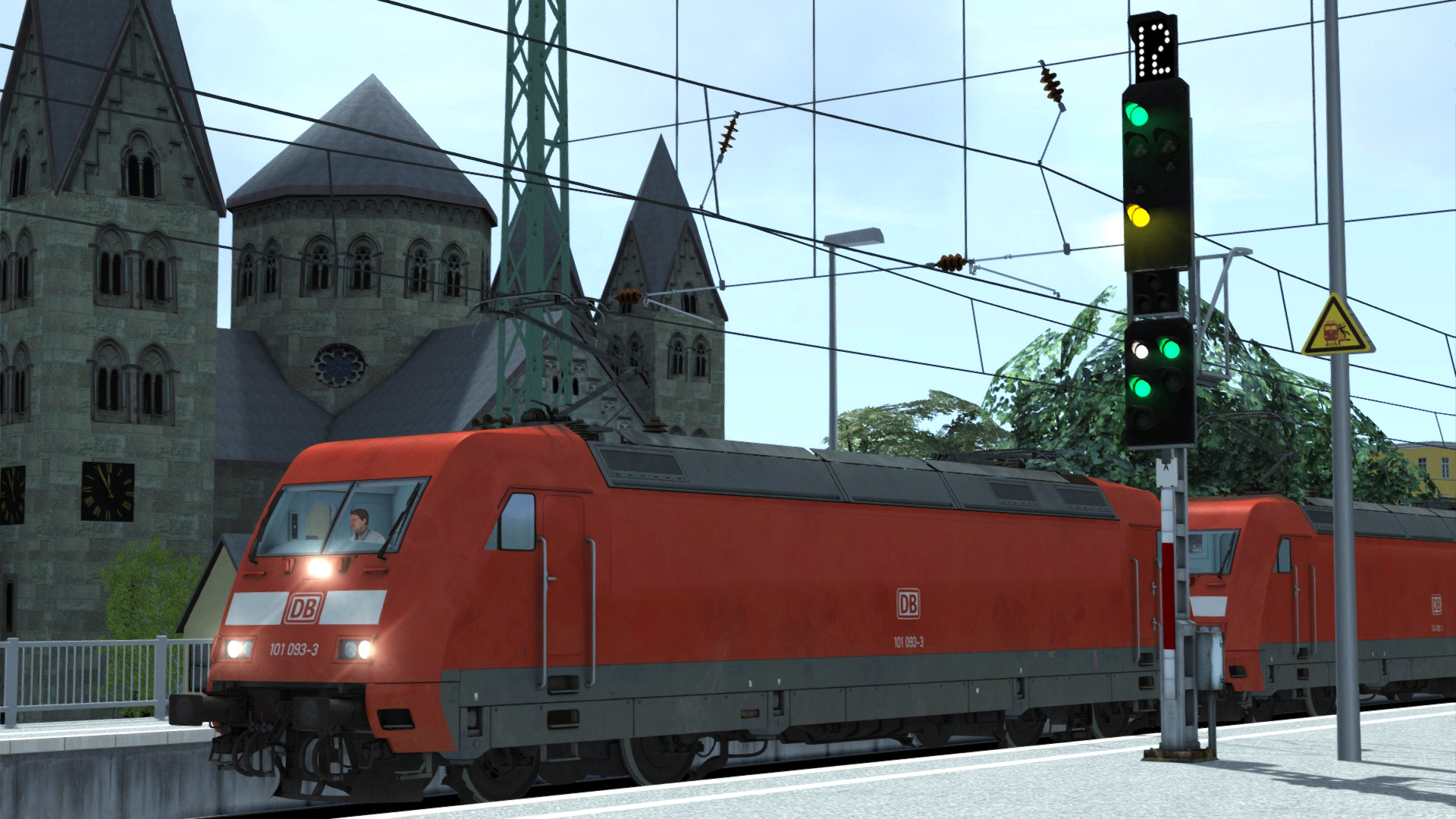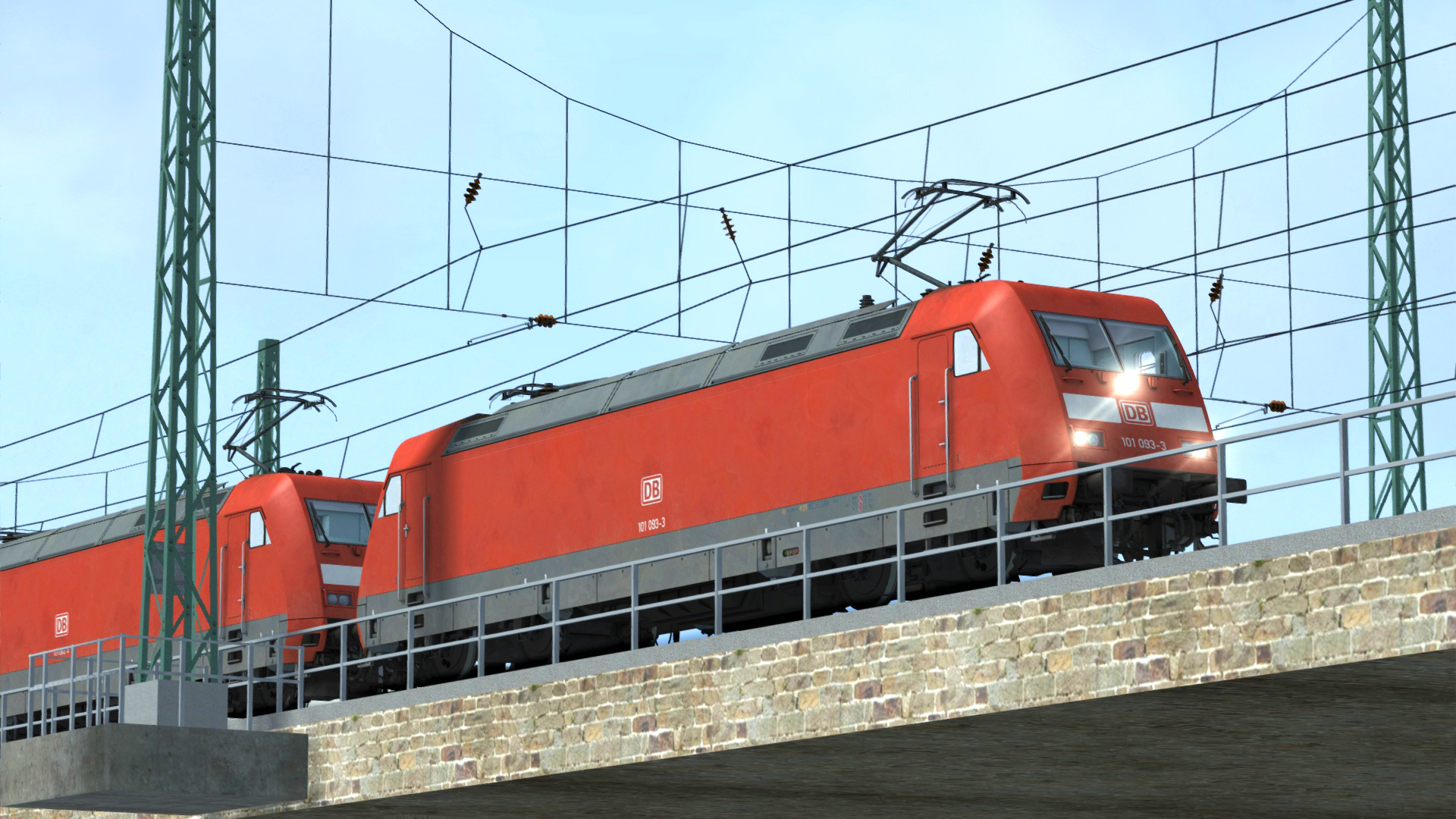Train Simulator: DB BR 101 Loco Add-On
The DB BR 101 is a classic among the modern electric locomotives of Germany, with heritage spanning some of the nation’s most revolutionary designs and continuing the honour by working throughout the Deutsche Bahn network every day. Partner Programme Developer Virtual Railroads brings this classic locomotive to life in a true expert simulation of the class as it joins the Pro Range line-up for Train Simulator.
In the early 1990s, a majority of Germany’s express passenger services were undertaken by locomotives that date back to the 1970s including the DB BR 103 and DB BR 120. Both once-revolutionary locomotives had more than outlived their purpose where they were now hauling heavier trains than they had ever been designed for, this resulted in a lot of damage over time with increasingly poor reliability rates and maintenance costs. Germany was in desperate need of a new express passenger locomotive.
Following the reunification of Germany, the newly formed Deutsche Bahn AG (DBAG) went on the lookout for designs, with many manufacturing companies bidding for the deal. There were over 30 designs in the second phase of bidding some of which were quickly eliminated, in particular the non-German manufacturers. One company in particular, ABB Henschel, didn’t even have a design ready to show, but more of a concept known as the Eco2001. The Eco2001 was basically 2 modified DB BR 120s, with changes to various components that massively increases the reliability of the locomotives.
In 1994, DB signed a deal with ABB which would develop into an order of 145 locomotives the following year, with the first locomotive completed and displayed in the Orient Red livery by July 1996. Around this time, ABB had merged with AEG to form ADtranz, this was beneficial because it meant the future DB BR 101s would be built quicker in multiple locations. Different components were built at a variety of facilities, with the final assembly taking place in Poland. The first DB BR 101 officially entered service in February 1997.
The DB BR 101 was designed and produced to be an efficient, high speed passenger locomotive and is capable of achieving this in part due to the carefully structured sloped front and rear of the locos. This slope may look extreme in places, but it optimises streamlined efficiency to its maximum especially when compared to its cost-effectiveness. The slope is also designed not to disrupt the flow of air between the rear of the locomotive and whatever it may be hauling. The DB BR 101 was also designed with bogies derived from the ICE series, as a basis for potential speed modifications in the future, as fast as 250 km/h.
All 145 locomotives were completed by 1999 and entered service hauling express passenger services across the Deutsche Bahn network including the likes of the Nuremberg – Munich High Speed Line where the 101s operate the fastest regional service in Germany at 200 km/h. All the DB BR 101s are based in Hamburg where they receive their periodic safety checks and maintenance, they were originally based in Frankfurt, but with the rapid increase of the various ICE series’ and push-pull operated consists, they were moved to Hamburg despite the amount of driver training that would require, the 101s sometimes visit Nuremburg for major maintenance works.
The basis of the DB BR 101 has its roots in some of the most ground breaking electric locomotives, so much so it shares a lot of heritage with the popular TRAXX series of locomotives and a variation of the DB BR 101 was ordered for a most unlikely customer, New Jersey Transit, which in the early 2000s worked with ADtranz/Bombardier to procure their ALP-46 and ALP-46A locomotives.
More scenarios are available on Steam Workshop online and in-game. Train Simulator’s Steam Workshop scenarios are free and easy to download, adding many more hours of gameplay. With scenarios being added daily, why don’t you check it out now!
In the early 1990s, a majority of Germany’s express passenger services were undertaken by locomotives that date back to the 1970s including the DB BR 103 and DB BR 120. Both once-revolutionary locomotives had more than outlived their purpose where they were now hauling heavier trains than they had ever been designed for, this resulted in a lot of damage over time with increasingly poor reliability rates and maintenance costs. Germany was in desperate need of a new express passenger locomotive.
Following the reunification of Germany, the newly formed Deutsche Bahn AG (DBAG) went on the lookout for designs, with many manufacturing companies bidding for the deal. There were over 30 designs in the second phase of bidding some of which were quickly eliminated, in particular the non-German manufacturers. One company in particular, ABB Henschel, didn’t even have a design ready to show, but more of a concept known as the Eco2001. The Eco2001 was basically 2 modified DB BR 120s, with changes to various components that massively increases the reliability of the locomotives.
In 1994, DB signed a deal with ABB which would develop into an order of 145 locomotives the following year, with the first locomotive completed and displayed in the Orient Red livery by July 1996. Around this time, ABB had merged with AEG to form ADtranz, this was beneficial because it meant the future DB BR 101s would be built quicker in multiple locations. Different components were built at a variety of facilities, with the final assembly taking place in Poland. The first DB BR 101 officially entered service in February 1997.
The DB BR 101 was designed and produced to be an efficient, high speed passenger locomotive and is capable of achieving this in part due to the carefully structured sloped front and rear of the locos. This slope may look extreme in places, but it optimises streamlined efficiency to its maximum especially when compared to its cost-effectiveness. The slope is also designed not to disrupt the flow of air between the rear of the locomotive and whatever it may be hauling. The DB BR 101 was also designed with bogies derived from the ICE series, as a basis for potential speed modifications in the future, as fast as 250 km/h.
All 145 locomotives were completed by 1999 and entered service hauling express passenger services across the Deutsche Bahn network including the likes of the Nuremberg – Munich High Speed Line where the 101s operate the fastest regional service in Germany at 200 km/h. All the DB BR 101s are based in Hamburg where they receive their periodic safety checks and maintenance, they were originally based in Frankfurt, but with the rapid increase of the various ICE series’ and push-pull operated consists, they were moved to Hamburg despite the amount of driver training that would require, the 101s sometimes visit Nuremburg for major maintenance works.
The basis of the DB BR 101 has its roots in some of the most ground breaking electric locomotives, so much so it shares a lot of heritage with the popular TRAXX series of locomotives and a variation of the DB BR 101 was ordered for a most unlikely customer, New Jersey Transit, which in the early 2000s worked with ADtranz/Bombardier to procure their ALP-46 and ALP-46A locomotives.
Included Scenarios
The DB BR 101 Loco Add-on includes three challenging career scenarios for the West Rhine: Köln - Koblenz Route Add-On:- EC 115 to Klagenfurt
- IC 2226 to Kiel
- ICE 558 replacement service to Bonn
More scenarios are available on Steam Workshop online and in-game. Train Simulator’s Steam Workshop scenarios are free and easy to download, adding many more hours of gameplay. With scenarios being added daily, why don’t you check it out now!
Key Features
- Authentic and prototypical simulation of the DB BR 101
- Complex regulation system with AFB and LZB
- Prototypical PZB90 V2.0
- Time-Time SIFA
- Brake modes R-P-G
- Brake system with overcharging of the main air pipe pressure
- High braking for the locomotive brakes in R
- Delayed and smoothly regulated e-brake
- Pantographs selectable and preselectable with sparks with sound
- Double formation and push-pull formation
- Spoken system announcements with priority
- Usable EBuLa (very basic)
- Switchable instrument lights
- Reading lamp and cab light
- Wipers with interval control
- vR ZZA and door system compatible
- SSTF like doors interlocking system
- Selectable language
- Realistic sounds optimized for EFX
- Challenging career scenarios for the West Rhine: Köln - Koblenz route
- Quick Drive compatible
- Download Size: 213.5 MB







